Related Research Articles

Palamu district is one of the twenty-four districts of Jharkhand, India. It was formed in 1892. The administrative headquarters of the district is Medininagar, situated on the Koel River.

Ahmad Shah Bahadur, also known as Mirza Ahmad Shah or Mujahid-ud-Din Ahmad Shah Ghazi, was the fourteenth Mughal emperor, born to Emperor Muhammad Shah. He succeeded his father to the throne in 1748, at the age of 22. When Ahmed Shah Bahadur came to power, the Mughal Empire started to decline. Furthermore, his administrative weakness eventually led to the rise of the usurping Imad-ul-Mulk.

Shah Alam II, also known by his birth name Ali Gohar, or Ali Gauhar, was the seventeenth Mughal emperor and the son of Alamgir II. Shah Alam II became the emperor of a crumbling Mughal Empire. His power was so depleted during his reign that it led to a saying in the Persian language, Sultanat-e-Shah Alam, Az Dilli ta Palam, meaning, 'The empire of Shah Alam is from Delhi to Palam', Palam being a suburb of Delhi.

Arrah is a city and a municipal corporation in Bhojpur district in the Indian state of Bihar. It is the headquarters of Bhojpur district, located near the confluence of the Ganges and Sone rivers, some 24 mi (39 km) from Danapur and 36 mi (58 km) from Patna.
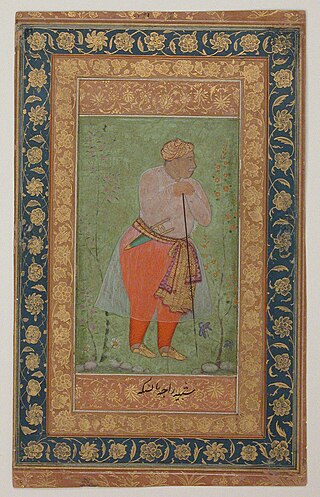
Mirza RajaMan Singh I was the 24th Maharaja of Kingdom of Amber from 1589 to 1614. He also served as the Subahdar of Bengal for three terms from 1595 to 1606 and the Subahdar of Kabul from 1585 to 1586. He served in the Mughal Army under Emperor Akbar. Man Singh fought sixty-seven important battles in Kabul, Balkh, Bukhara, Bengal and Central and Southern India. He was well versed in the battle tactics of both the Rajputs as well as the Mughals. He is commonly considered to be one of the Navaratnas, or the nine (nava) gems (ratna) of the royal court of Akbar.

Bhojpur district is one of the 38 districts of the Indian state of Bihar. Arrah city is the administrative headquarters of this district. Bhojpur district came into existence in 1972. Earlier it was the part of Shahabad district. This district is named "Bhojpur" after great Parmara King Bhoja as most early settlers were Rajput rulers of Parmara dynasty then called as Ujjainiya.

Hafiz Rahmat Khan was the Regent of Rohilkhand in North India, from 1749 to 1774. He was a Pashtun by background, ruling over Rohillas. Hafiz Rahmat Khan had served honorably throughout the reign of three Mughal Emperors: Ahmad Shah Bahadur, Alamgir II and Shah Alam II. He was also a mentor of Prince Mirza Jawan Bakht.

Kingdom of Marwar, also known as the Jodhpur State under the British, was a kingdom in the Marwar region from 1243 to 1818 and a princely state under British rule from 1818 to 1947. It was established in Pali by Rao Siha, possibly a migrant Gahadavala noble, in 1243. His successors continued to struggle against regional powers for domination and 9 out of 15 rulers till 1438 died in combat. In 1395, its capital was changed to Mandore by Rao Chunda of Mandore and to Jodhpur in 1459 by Rao Jodha.
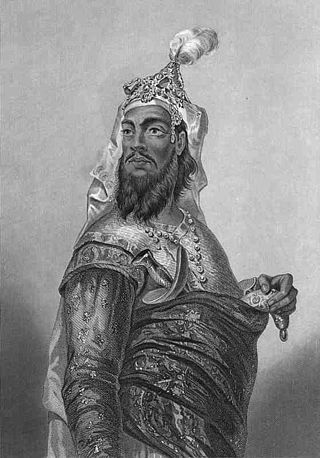
Kunwar Singh, also known as Babu Kunwar Singh was a chief organiser of the Indian Rebellion of 1857 from the Bhojpur region of Bihar. He was originally the ruler of Jagdishpur estate. He led a selected band of armed soldiers against the troops under the command of the British East India Company.
Ranchi district is one among the twenty-four districts of the state of Jharkhand in Eastern India. This region was under the control of the Magadha Empire, then it was a part of the Mauryan Empire under Ashoka and later a part of the Gupta Empire. After the fall of the Gupta Empire a legendary king named Phanimukut established the Nagvanshi dynasty and controlled the Chota Nagpur plateau region for several centuries thereafter.

Jagdishpur is a nagar panchayat town of the district Bhojpur of the state of Bihar in eastern India. It was the capital of the eponymous Jagdishpur Raj ruled by Rajputs of the Ujjainiya clan. One of its rulers, Kunwar Singh, was a major figure in the Indian Rebellion of 1857, considered the leader of the rebellion in Bihar.
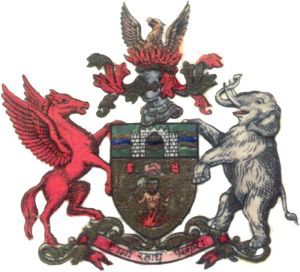
The Ujjainiya or Ujjainia is a clan of Rajputs mainly found in Bihar and Purvanchal. They are an off-shoot of Paramara dynasty of Malwa. The Ujjainiya dynasty historically ruled over the parts of Bhojpuri region during the medieval era. They were mainly rulers and aristocrats holding major power of the region.

Dost Mohammad Khan was the founder of Bhopal State in central India. He founded the modern city of Bhopal, the capital of the modern day Madhya Pradesh state.
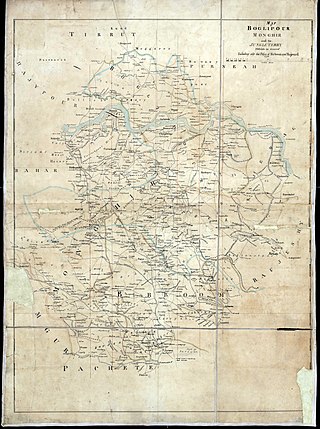
Kharagpur Raj was a prominent chieftaincy, founded in the early 16th century in Bihar situated mainly in modern-day Munger district. They were notable for being one of the few chieftaincies in Bihar to convert to Islam and many of the rulers became firm allies of the Mughal authorities. At its peak, the Kharagpur Raj encompassed parts of the modern-day districts of Munger, Bhagalpur, Jamui, Lakhisarai, Godda and Deoghar. Due to its size, the Privy Council compared it with the Kingdom of Sardinia.
The Chero dynasty or Chyavana dynasty was a polity that ruled the northern regions of the Indian subcontinent, corresponding to the present-day Indian states of Bihar, Uttar Pradesh, and Jharkhand, after the fall of the Pala Empire; their rule lasted from the 12th century CE to the middle of the 15th century.

The Dumraon Raj was a feudal principality in the Bhojpur region ruled by the Ujjainiya dynasty. The principality was founded when Raja Horil Singh founded a separate capital for himself in the town of Dumraon. The name Dumraon Raj came from its capital town.
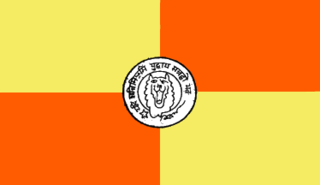
The Jagdishpur Raj was a feudatory zamindari ruled by a cadet branch of the Ujjainiya dynasty. It was situated in modern-day Jagdishpur, in the erstwhile Shahabad district of Bihar. The capital of the principality was the town of Jagdishpur by which the principality derived its name.

Bhojpur Kadim is a historic village in Dumraon block of Buxar district, Bihar, India. As of 2011, its population was 18,243, in 3,024 households. Together with the neighboring Bhojpur Jadid, it lends its name to the surrounding Bhojpuri region.
Raja Gajpati Ujjainia, also known as Raja Gajpati Sahi was a ruler of Bhojpur belonging to the Ujjainiya dynasty.
Raja Sangram Singh was ruler of Kharagpur Raj in the 16th century. He was a contemporary of Akbar. Sangram Singh initially was allegiance to Akbar, but during the reign of Jahangir, he declared himself independence and was killed during battle with Mughal forces due to assassination. After his death, his son Toral Mal converting to Islam, changed his name to Roz Afzun, became loyal of Mughal and deployed as king of Kharagpur by Jahangir.
References
- 1 2 3 4 Tahir Hussain Ansari (20 June 2019). Mughal Administration and the Zamindars of Bihar. Taylor & Francis. pp. 85–90. ISBN 978-1-00-065152-2.
- 1 2 Surendra Gopal (22 December 2017). Mapping Bihar: From Medieval to Modern Times. Taylor & Francis. pp. 313–. ISBN 978-1-351-03416-6.
- ↑ Qeyamuddin Ahmad (1959). "A Historical Account of Chotanagpur in the 18th Century by Raja Shitab Rai". Proceedings of the Indian History Congress. 22: 378–389. JSTOR 44304326.